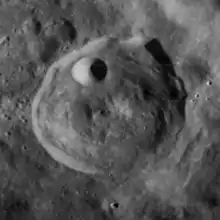Neander (crater)
Neander is a lunar impact crater that is located to the south of Mare Nectaris, in the southeastern part of the Moon's near side. It was named after 16th century German mathematician Michael Neander.[1] To the west-northwest lies the prominent crater Piccolomini. The northwestern extension of the Vallis Rheita lunar valley passes about a crater diameter to the west of this formation.

 LRO image | |
| Coordinates | 31.3°S 39.9°E |
|---|---|
| Diameter | 50 km |
| Depth | 3.4 km |
| Colongitude | 321° at sunrise |
| Eponym | Michael Neander |
The rim of Neander is roughly circular and somewhat sharp-edged, with some ledges formed along the inner sides. The circular, cup-shaped Neander A lies along the northwestern inner wall. The interior floor is uneven, with a formation of central peaks located at the midpoint.
Satellite craters
By convention these features are identified on lunar maps by placing the letter on the side of the crater midpoint that is closest to Neander.
| Neander | Latitude | Longitude | Diameter |
|---|---|---|---|
| A | 30.9° S | 39.6° E | 11 km |
| B | 28.2° S | 40.1° E | 9 km |
| C | 28.6° S | 36.0° E | 20 km |
| D | 26.5° S | 42.4° E | 11 km |
| E | 29.8° S | 40.7° E | 25 km |
| F | 32.1° S | 37.9° E | 22 km |
| G | 33.4° S | 43.8° E | 18 km |
| H | 33.0° S | 42.4° E | 13 km |
| J | 34.0° S | 43.4° E | 13 km |
| K | 35.0° S | 39.8° E | 14 km |
| L | 31.3° S | 41.8° E | 21 km |
| M | 34.8° S | 37.7° E | 11 km |
| N | 32.4° S | 37.2° E | 17 km |
| O | 35.6° S | 39.1° E | 13 km |
| P | 28.4° S | 41.1° E | 6 km |
| Q | 28.8° S | 41.4° E | 6 km |
| R | 33.2° S | 38.6° E | 12 km |
| S | 31.9° S | 42.1° E | 12 km |
| T | 29.9° S | 38.4° E | 10 km |
| V | 31.3° S | 38.2° E | 5 km |
| W | 32.3° S | 38.5° E | 9 km |
| X | 33.1° S | 37.8° E | 8 km |
| Y | 34.5° S | 38.2° E | 8 km |
| Z | 33.8° S | 42.0° E | 7 km |
References
- "Neander (crater)". Gazetteer of Planetary Nomenclature. USGS Astrogeology Research Program.
- Andersson, L. E.; Whitaker, E. A. (1982). NASA Catalogue of Lunar Nomenclature. NASA RP-1097.CS1 maint: ref=harv (link)
- Bussey, B.; Spudis, P. (2004). The Clementine Atlas of the Moon. New York: Cambridge University Press. ISBN 978-0-521-81528-4.CS1 maint: ref=harv (link)
- Cocks, Elijah E.; Cocks, Josiah C. (1995). Who's Who on the Moon: A Biographical Dictionary of Lunar Nomenclature. Tudor Publishers. ISBN 978-0-936389-27-1.CS1 maint: ref=harv (link)
- McDowell, Jonathan (July 15, 2007). "Lunar Nomenclature". Jonathan's Space Report. Retrieved 2007-10-24.CS1 maint: ref=harv (link)
- Menzel, D. H.; Minnaert, M.; Levin, B.; Dollfus, A.; Bell, B. (1971). "Report on Lunar Nomenclature by the Working Group of Commission 17 of the IAU". Space Science Reviews. 12 (2): 136–186. Bibcode:1971SSRv...12..136M. doi:10.1007/BF00171763.CS1 maint: ref=harv (link)
- Moore, Patrick (2001). On the Moon. Sterling Publishing Co. ISBN 978-0-304-35469-6.CS1 maint: ref=harv (link)
- Price, Fred W. (1988). The Moon Observer's Handbook. Cambridge University Press. ISBN 978-0-521-33500-3.CS1 maint: ref=harv (link)
- Rükl, Antonín (1990). Atlas of the Moon. Kalmbach Books. ISBN 978-0-913135-17-4.CS1 maint: ref=harv (link)
- Webb, Rev. T. W. (1962). Celestial Objects for Common Telescopes (6th revised ed.). Dover. ISBN 978-0-486-20917-3.CS1 maint: ref=harv (link)
- Whitaker, Ewen A. (1999). Mapping and Naming the Moon. Cambridge University Press. ISBN 978-0-521-62248-6.CS1 maint: ref=harv (link)
- Wlasuk, Peter T. (2000). Observing the Moon. Springer. ISBN 978-1-85233-193-1.CS1 maint: ref=harv (link)
| Wikimedia Commons has media related to Neander (crater). |
